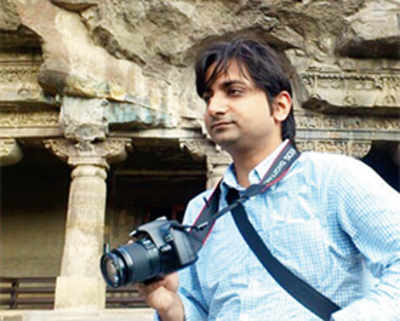Field day: Past, present

A BEST electrical engineer from Dombivli spends weekends around a dwarfed Gateway.
Kunal Tripathi’s tryst with history began a year-and-a-half ago. “Thanks to my job, I visited places within Mumbai that I’d never heard of,” says Tripathi, 29, an electrical engineer with BEST. “I realised, like me, there were hundreds of Mumbaikars who had little idea of the history that surrounds them,” he adds.
To bridge the gap, the Dombivli resident started an account on Instagram, and then Twitter (both run by the name mumbaiheritage), to post information on lesser known heritage sites in and around the city. Villa Vienna, a heritage bungalow on Bandra Bandstand that is now home to Shah Rukh Khan, also finds a mention.
When he is not part of an army that makes sure Mumbai gets its power supply uninterrupted, he is spending his weekends finding heritage jewels. Tripathi picks two of his favourites that should make it to your Sunday must-do list.
1. A tiny Gateway of India: You don’t have to trudge to Apollo Bunder to gaze lovingly at the Gateway of India. There’s a smaller four feet version to be enjoyed at Gamdevi Market. Contractor Yashwantrao Harishchandra Desai, who also worked on the original monument, built it. The stone used in both monuments is the same. The one at Gamdevi stands in the stilt of the building in which Desai’s family still resides, and remain caretakers of the model.
2. The Kwan Tai Shek Chinese Temple: This temple in a bylane of Nawab Tank Road, near Kamgar Sadan Building, Mazagaon, is one of the last few symbols of the city’s once thriving Chinese population. Up to the 1960s, Mumbai had its own small Chinatown in Mazagaon, which is why the temple and adjoining cemetery still stand in this neighbourhood. Set up in 1919, the temple was a tribute to General Kwan Tai Kon, a righteous warrior, whose statue stands in a golden altar. Cantonese Hong Kong sailors who worked for the East India Company built it in his honour since they were seeking moral guidance in their foray into an unknown territory called India.
Kunal Tripathi’s tryst with history began a year-and-a-half ago. “Thanks to my job, I visited places within Mumbai that I’d never heard of,” says Tripathi, 29, an electrical engineer with BEST. “I realised, like me, there were hundreds of Mumbaikars who had little idea of the history that surrounds them,” he adds.
To bridge the gap, the Dombivli resident started an account on Instagram, and then Twitter (both run by the name mumbaiheritage), to post information on lesser known heritage sites in and around the city. Villa Vienna, a heritage bungalow on Bandra Bandstand that is now home to Shah Rukh Khan, also finds a mention.
But a building that took Tripathi by surprise was Sardargrah in Crawford Market. “Lokmanya Tilak used to stay there. After reading about it in a book, I made a trip and was glad that it still exists,” he says, adding that the freedom fighter breathed his last here on August 1, 1920, in a room on the fourth floor. Today, the room houses the office of Kesari, the Marathi newspaper he launched in 1881.
When he is not part of an army that makes sure Mumbai gets its power supply uninterrupted, he is spending his weekends finding heritage jewels. Tripathi picks two of his favourites that should make it to your Sunday must-do list.
1. A tiny Gateway of India: You don’t have to trudge to Apollo Bunder to gaze lovingly at the Gateway of India. There’s a smaller four feet version to be enjoyed at Gamdevi Market. Contractor Yashwantrao Harishchandra Desai, who also worked on the original monument, built it. The stone used in both monuments is the same. The one at Gamdevi stands in the stilt of the building in which Desai’s family still resides, and remain caretakers of the model.
2. The Kwan Tai Shek Chinese Temple: This temple in a bylane of Nawab Tank Road, near Kamgar Sadan Building, Mazagaon, is one of the last few symbols of the city’s once thriving Chinese population. Up to the 1960s, Mumbai had its own small Chinatown in Mazagaon, which is why the temple and adjoining cemetery still stand in this neighbourhood. Set up in 1919, the temple was a tribute to General Kwan Tai Kon, a righteous warrior, whose statue stands in a golden altar. Cantonese Hong Kong sailors who worked for the East India Company built it in his honour since they were seeking moral guidance in their foray into an unknown territory called India.
GALLERIES View more photos















